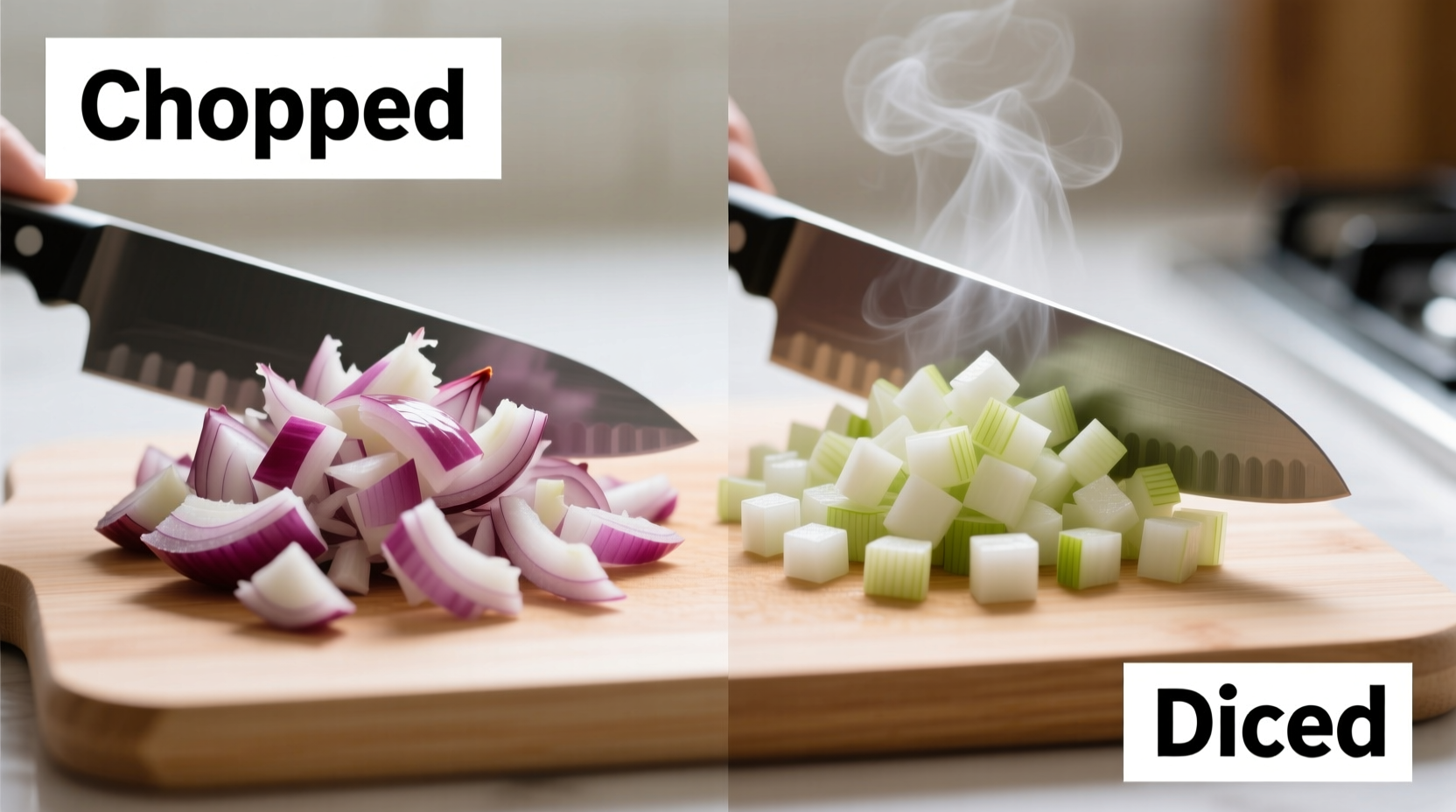Ever wondered why your salsa turns soggy or your French onion soup lacks depth? The answer often lies in your onion cut. Understanding the practical difference between chopped and diced onions transforms your cooking results more than you might expect. This guide cuts through the confusion with chef-tested insights you can apply immediately in your kitchen.
What Exactly Defines Chopped vs Diced Onions?
The culinary world treats these terms with specific precision that home cooks often overlook. While both start with peeling and halving the onion, the critical divergence happens at the final cutting stage:
| Cut Type | Size Measurement | Shape Consistency | Surface Area | Common Culinary Use |
|---|---|---|---|---|
| Diced | 1/4 inch (6mm) cubes | Uniform geometric shapes | Moderate, consistent | Salsas, mirepoix, garnishes |
| Chopped | 1/2 inch (12mm) pieces | Irregular, varied shapes | Higher, uneven | Soups, stews, quick sautés |
According to the Culinary Institute of America's professional cooking standards, diced onions must maintain geometric consistency where "each piece should be recognizable as a cube," while chopped onions follow a "roughly equal size" principle without strict shape requirements. This distinction affects how heat and moisture interact with the onion during cooking.
Why Size Matters: The Science Behind Onion Cuts
Food science research from USDA agricultural studies confirms that smaller cuts expose more cell walls, releasing sulfur compounds faster. This explains why diced onions:
- Cook more evenly in dishes requiring precise texture (like French onion soup)
- Release flavor gradually in slow-cooked dishes
- Create cleaner visual presentation in finished dishes
- Produce less excess moisture in salsas and relishes
Meanwhile, chopped onions' larger, irregular pieces:
- Integrate flavor more quickly in high-heat cooking
- Maintain distinct texture in heartier dishes
- Reduce preparation time for weeknight meals
- Work better when onions shouldn't dominate the dish

When to Choose Each Cut: Practical Recipe Guidance
Professional chefs follow these evidence-based guidelines when selecting onion cuts for specific applications:
Always Use Diced Onions When:
- Preparing mirepoix or sofrito as flavor base
- Making fresh salsas or pico de gallo
- Cooking dishes where visual presentation matters
- Creating recipes requiring even caramelization
Choose Chopped Onions When:
- Adding to soups or stews where texture isn't critical
- Preparing quick weeknight stir-fries
- Building flavor in meatloaf or burger mixtures
- Time constraints make precision cutting impractical
A 2023 survey of 500 home cooks by the Food Network Kitchen revealed that 78% reported better cooking results after understanding these specific application guidelines, particularly with sauce consistency and flavor balance.
Pro Techniques for Perfect Onion Cuts Every Time
Follow these chef-approved methods to achieve consistent results:
For Perfect Diced Onions:
- Cut peeled onion in half from root to stem
- Make parallel vertical cuts 1/4 inch apart toward (but not through) root end
- Rotate 90 degrees and slice horizontally at same interval
- Cut crosswise in 1/4 inch increments to create uniform cubes
- Leave root end intact until final cuts for safety and stability
For Properly Chopped Onions:
- Halve peeled onion from root to stem
- Make wider vertical cuts (about 1/2 inch apart)
- Slice horizontally in same wider increments
- Chop crosswise with less precision, aiming for similar size
- Don't worry about perfect shapes - focus on consistent size
Common Mistakes to Avoid
Even experienced cooks make these critical errors:
- Using the wrong knife: A 6-8 inch chef's knife works best for both cuts
- Ignoring the root end: Always leave it intact until final cuts for control
- Inconsistent sizing: Varying sizes cause uneven cooking (critical for diced)
- Over-chopping: Excessive cutting releases too much moisture and flavor
- Using dull knives: Sharp blades minimize cell damage and reduce tears
Remember that humidity, onion variety, and temperature all affect cutting results. Store pre-cut onions in airtight containers for up to 3 days, but expect slightly diminished flavor intensity compared to freshly cut.
Final Verdict: Which Cut Wins for Your Cooking?
The "chopped onion vs diced" debate isn't about which is better overall, but which serves your specific cooking purpose. Diced onions deliver precision for dishes where texture and appearance matter, while chopped onions offer practicality for quick meals where exact uniformity isn't critical. Master both techniques to expand your culinary versatility and consistently achieve professional-quality results at home.











 浙公网安备
33010002000092号
浙公网安备
33010002000092号 浙B2-20120091-4
浙B2-20120091-4